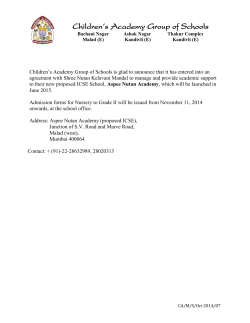
The Norwegian Academy of Science and Letters
The Norwegian Academy of Science and Letters Inger Moen, Vice-President, The Norwegian Academy of Science and Letters The first university in Norway was founded in 1811 and established in Christiania. Prior to the establishment of a national university, Norwegian students had received their education abroad. Many never returned to take up careers in Norway, and those who did were too few to form an academic community. In the years following 1811 there gradually developed a circle of scholars and scientists in and around the University. And by 1857 when the Norwegian Academy of Science and Letters was established, this circle was large enough to support the activities of a national academy. It was important for the scientists in Christiania to become integrated in the European scientific community, and to this end a channel for publication was vital. The Academy therefore had as its main aim the publication of scholarly work. A government grant was allocated to support the publication activities. From 1814, following the Napoleonic wars, Norway had been joined in a union with Sweden. Towards the end of the century a growing opposition developed in Norway to a union which prevented the country from functioning as an independent nation. In 1896 the scientist and explorer Fridtjof Nansen returned from an expedition towards the North Pole. The expedition inspired an unprecedented surge of patriotic fervour. Nansen was celebrated as a national hero, a symbol of strength and independence. To commemorate the expedition a fund raising campaign was initiated, a campaign which resulted in the establishment of a research fund in Fridtjof Nansen's name. The Academy was given the administrative responsibility for the fund. The Nansen Fund was the main financial resource for scientific and scholarly work in Norway until the establishment of the Norwegian Research Council in 1949. Interior from the Academy (DNVA) Today the Academy has 219 ordinary Norwegian members and 183 foreign members organised in two divisions, one for the natural sciences and one for the humanities and social sciences. Each division is subdivided into sections for the constituent disciplines. The Academy receives a Government grant-in-aid and administers its own private funds arising from gifts and legacies Since June 1911 the Academy has been located at Drammensveien 78, a building which was designed by the architect Herman Major Backer and built as a private home for Hans Rasmus Astrup and his family in 1887. The house is built in the neo-Renaissance style and is richly decorated with large chandeliers, elaborate ceilings and wall decorations in the aesthetic tradition of the romantic Historicism characteristic of the second half of the nineteenth century. Ten years ago the basement and the attic were renovated and turned into modern offices which now house the Centre for Advanced Study. The Norwegian Academy of Science and Letters, as the founding organisation for the Centre for Advanced Study, is responsible for securing the academic quality of the research groups working in the Centre. The Academy is well qualified for this responsibility. It counts as its members Norway's most distinguished scholars and scientists. Through its collaboration with a number of sister academies in other countries it has established a wide international scientific network. The Academy also acts as the official representative of Norway in a number of international scientific organisations such as The International Council of Scientific Unions (ICSU), Union Académique Internationale (UAI), The European Science Foundation (ESF). The Academy has as its main aims to represent the interests of scholarship nationally and internationally, to promote and support advanced research, and to further international collaboration and exchange. The Centre for Advanced Study is an important component in the Academy's efforts to fulfil these aims.
© Copyright 2025





















